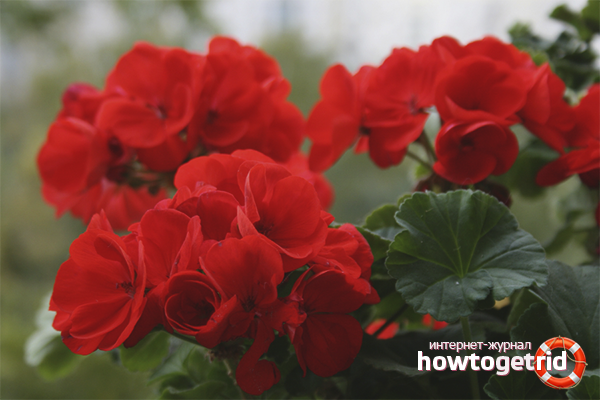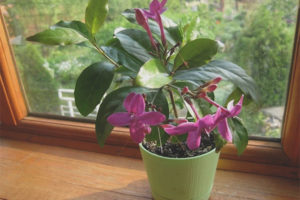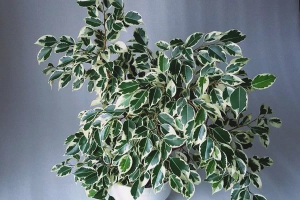The content of the article
Indoor geranium is of two types: ampelous and compact bush. Curly and squat varieties are grown on window sills in ordinary pots. Domestic plants have large and bright flowers, oblong fruits and a pleasant aroma that repels insect pests. The most popular species is zonal geranium, but gardeners grow both fragrant and royal varieties. The flower belongs to the group of unpretentious plants, but even he needs proper care.
Ultraviolet
Ornamental geranium bushes, also called pelargonium and crane, live in the southern window sills in winter. A plant devoid of ultraviolet light is stretched, and its leaves and inflorescences become small and faded. In the spring, the indoor flower moves to the southeast window. Here it is until late autumn.
In summer, geranium sunbathes in direct sunlight. Pelargonium is not afraid of burns, it actively absorbs ultraviolet light and turns it into energy. Geranium is not recommended to be put in the shade, otherwise the bush will become sluggish and weak, will not be able to resist the fungus and insects. The main thing is to rotate the pot daily so that the light falls on all sides of the crane.
Pelargonium does not like only the midday summer sun. The liquid from leaves and petals evaporates under the influence of unscattered ultraviolet radiation, burns remain on the surface. From 12 noon to 2-15 p.m., the pot of geraniums is removed from the windowsill and placed on a shelf or stand near the window so that muted sunlight falls on the bush.
In winter, pelargonium must be supplemented with phytolamps. Special equipment sold in garden stores and department stores compensates for the lack of natural UV light. Lamps increase the duration of daylight hours and provide geraniums with artificial sunlight, necessary for photosynthesis. The leaves of pelargonium, devoid of ultraviolet light, turn pale and fall, and new ones grow small and inconspicuous.
Watering
Ornamental bush refers to drought tolerant plants. In the root system, which is constantly flooded, a fungus appears. Mold provokes decay of the flower, leading to its death. With a lack of water, the stems and leaves acquire a pale green hue, and the inflorescences become small and deformed.
In winter, the substrate in a pot of geraniums is moistened three times a month. In spring, the frequency of irrigation is increased by 2–2.5 times. In summer, water is added after the topsoil has dried. In the hot months, the flower is watered every 2-3 days.
The root system of pelargonium negatively reacts to impurities of heavy metals. Harmful additives reduce the quality of the substrate and slow down the metabolism of geraniums. The soil is moistened with melt or distilled water. The liquid from the tap is upheld for at least 3-4 days. Only the top layer is drained, in which there is a minimum of harmful additives. In summer and autumn, rainwater is collected.
Geranium must not be sprayed from a spray bottle. It tolerates low humidity and dry air, but can get sick due to droplets of water remaining on the leaves and stem. Water heated to room temperature is poured directly onto the root. Use plastic bottles or special watering cans with a thin nose.
Watering is reduced by 2-3 times if:
- the leaves became lethargic;
- a white or gray coating appeared on the bush;
- the substrate exudes an unpleasant putrefactive odor;
- the stem of geranium is blackened;
- leaves or roots rot.
A flower infected with mold will save only emergency transplantation into a new pot with a dry substrate.
Pelargonium leaves must not be washed or wiped with a damp cloth. Dust is removed with dry sponges. The pot intended for the ornamental bush should have drainage holes. The geranium root system accumulates as much water as a flower needs for normal development. Excess drains into pallets. The remaining moisture is poured. In stagnant water, mold actively propagates.
Temperature and feeding
Geranium at +12 and below discards leaves. The bare bushes are defenseless and weak, at sub-zero temperatures they die. In winter, pelargonium rests at + 13-15. The plant hibernates and is restored. In spring and summer, in the room in which the pot with geraniums is located, the temperature is maintained from +18 to + 24–25. A container with cold water or pieces of ice, which is placed next to the plant, helps to lower the degrees. The liquid gradually evaporates, increasing air humidity and protecting the root system of the ornamental bush from drying out.
Top dressing in winter is done once every 1.5–2 months. A flower in hibernation does not need recharge. A large dose of mineral fertilizers starts the vegetation, which weakens pelargonium. The frequency of top dressing increases from early spring to 1 time per week. Makeups are added to the substrate, which contain micro and macro elements:
- nitrogen;
- zinc;
- potassium;
- boron;
- manganese;
- phosphorus;
- calcium;
- iron;
- copper.
Mineral fertilizers provide lush flowering and stimulate the growth of the root system. Use complex replenishment, for example, "Merry Flower Girl". At home, preparations are made from nitrogen, potassium and phosphorus, mixed in equal proportions. But home-made options do not give the plant all the necessary components.
Organic fertilizers are contraindicated. Drinks are diluted with water in a ratio of 1 to 4. Too concentrated products burn the root system of the flower. Fertilizers are applied after heavy watering so that they are better absorbed. Stimulants are not used during heat. High temperatures combined with mineral recharge are stress for pelargonium.
Feeding is added to the new land after 3–3.5 months after transplantation. The decorative bush is fertilized in the morning so that it can absorb useful components in a day.
Shaping and trimming
At the end of November, pelargonium, dropping the last petal, is prepared for winter. The upper part of the bush is removed to provide air access to the lower leaves and to protect the plant from fungus. In late autumn, intersecting branches are also cut, which interfere with each other and slow down the development of geraniums. Indoor flower is cleaned of diseased, dry and rotting parts.
The removal of dead zones and tops is carried out with a sharp pruner or knife. The blade before cutting is wiped with antiseptics or pure alcohol. A bowl of crushed activated carbon is placed next to the pot. Sorbent is sprinkled on the slice places so that microbes and fungus do not get into the open wounds of the plant. Disinfectant powder is also prepared from charcoal.
5 cm recede from the decaying or infected area. The diseased area is removed along with a piece of a healthy branch. Pinch green shoots with clean fingers. The procedure is carried out when 4 leaf nodes are formed on a young branch. After 12 weeks, flower stalks form from them.
Branches directed to the outside are also cut. The upper part of the shoots is removed with sharp scissors, leaving only leafy nodules with buds. The procedure does not allow the branches of geraniums to grow inside the bush. If there are too many shoots, they will cover the substrate and root system from the sun, creating favorable conditions for the growth of mold.
Planned pruning for the formation of pelargonium is carried out in the fall. Parts of the plant that are too long or deformed can be removed in the spring. In summer and winter, they abstain from the procedure so as not to injure the geranium.The exception is branches and shoots affected by fungus or rot. They are removed immediately to prevent the spread of infection.
Winter geranium storage
Pots with cut geraniums are cleaned in a warm room with low humidity. Protect bushes from pests, fungi and drafts. The room is periodically ventilated. The plant needs fresh air for restoration and normal development. Loosen the soil and check how much water is in it. The substrate should be slightly moist, but not wet, otherwise the root system will begin to rot.
Indoor geranium is stored in a dry way:
- After the buds wither, the decorative bush is removed from the pot. Do not cut.
- Several geraniums are tied together and hung from the ceiling.
- In the room intended for storage of pelargonium, the temperature is maintained from +3 to +8.
- Humidity should be at least 75%. Flowers are periodically dipped in water at room temperature so that the root system does not dry out.
- In early spring, more than half of the ornamental bush is cut. Indoor flower is planted in a pot with prepared substrate, watered and fertilized.
Subject to all the rules, geraniums will have new shoots and peduncles with a large number of large and bright buds.
Substrate and pot
Pelargonium survives in wooden crates, plastic and ceramic pots. But the parameters of flowerpots should correspond to the size of the root system of the plant. Young geraniums are planted in small pots, and perennial old bushes are planted in large boxes. The main thing is that the roots occupy the entire capacity. In empty land, mold often starts and insects breed.
Transplanted decorative bushes in a loose substrate that allows air to pass through. The soil for geraniums is prepared at home from four components:
- leaf and turf land;
- peat;
- coarse sand.
When choosing a pot, preference is given to clay options with drainage holes. Plastic varieties retain water in the substrate, so mold often appears in such flowerpots. Crushed brick, expanded clay or grated foam is necessarily poured at the bottom of the geranium container. The drainage layer protects against stagnation of fluid and fungus.
The soil before irrigation is loosened with special spatulas to saturate the substrate with oxygen and check the moisture level.
Additional recommendations
Geranium is transplanted in two cases:
- When she outgrew the pot, and the root system peeps out from under the ground.
- In the soil due to abundant watering, a fungus started.
Transshipment is carried out in spring or autumn. The pot is rinsed with boiling water before the procedure. During the adaptation period, the plant is not watered or fertilized.
In the summer, the pot with pelargonium is taken out to the balcony or loggia, left in the garden under the trees. A flower loves fresh air, but even from a small draft can die.
With proper care, geranium annually pleases with bright inflorescences. Some peduncles form up to 30 buds. Pelargonium is one of the best options for beginners and forgetful gardeners, because it tolerates drought, direct sunlight and even heat. The main thing is to feed and trim the decorative bush in a timely manner, periodically water and loosen the substrate.
Video: proper care for geraniums












Submit